Heart Arrhythmia Write for Us

Heart Arrhythmia Write for Us – The term “arrhythmia” refers to any problem with the rate or rhythm of a person’s heartbeat. Throughout an arrhythmia, the electrical impulses may remain too fast, too slow, or irregular, causing the arrhythmia.
When the heart is not beating correctly, it cannot pump blood efficiently. When this happens, the lungs, brain, and all other structures don’t work correctly and may stop working or become damaged.
What Is The Normal Heart Rate?
Doctors determine a healthy heartbeat by counting the number of times the heart beats per minute (bpm) while at rest. It is known as your resting heart rate.
A healthy resting heart rate range varies, but the American Heart Association suggests it’s usually between 60 and 100 beats per minute.
This rate can change. It is frequently lower at night. Athletes may also have a latent heart rate of less than 60 bpm since their hearts are highly efficient.
The heart should beat in a regular rhythm consisting of double “ba-bum” beats with equal distances between each.
One of these beats is the heart’s contraction to provide oxygen to the blood that has already circulated, and the other includes the heart pushing oxygenized blood around the body.
A person can amount their heart rate using their pulse. It is the point where he can feel the heartbeat through the skin. The best spots on the body for this purpose are:
- wrists
- The insides of the elbows
- neck side
- the upper part of the foot
Heart: Four Chambers And Four Valves
The heart has four rooms, two on the right and two on the left:
- The two upper chambers are called the atria (one of them is called the atrium).
- The two lower chambers are called the ventricles.
The heart also has four valves that open and close to allow blood to flow in only one way when the heart contracts (beats). The four heart valves are:
- The tricuspid valve remains located between the right atrium and the right ventricle
- The pulmonary or pulmonic regulator between the right ventricle and the pulmonary vein
- The mitral regulator, between the left atrium and the left ventricle
- The aortic valve, amid the left ventricle and the aorta
Each valve has a set of blinkers (also called leaflets or cusps). The mitral valve has two flaps. Others have three. Blood flow only occurs when there is a pressure difference across the valves, causing them to open. Under normal circumstances, valves allow blood to flow in one direction only.
The heart pumps blood to the lungs and all body tissues by means of a series of highly regulated contractions of the four chambers. For the heart to function correctly, all four sections must beat in an orderly manner.
Heart Electrical System
Electrical signals control the pump.
The heartbeat (systole) begins when an electrical impulse travels from the sinus node (the SA node) through the heart’s muscle tissue. The SA node remains sometimes called the “natural pacemaker” because it initiates the heartbeat.
The standard electrical sequence starts in the right atrium and feasts throughout the atria to the atrioventricular (AV) node. From the AV node, electric impulses travel down its bundle and through Purkinje fibers causing the ventricles to contract.
An average heart beats regularly because the electrical impulses cause orderly contractions. An adult’s normal heart beats 60 to 100 times per minute.
An electrocardiogram (ECG or EKG) is a simple, painless process that records the heart’s electrical action and can help identify arrhythmias (abnormal heart rhythms).
What Does An Arrhythmia Feel Like?
An arrhythmia — sometimes called a dysrhythmia — occurs when the electrical signals that organize heartbeats don’t work correctly. An irregular heartbeat may feel like a competing heart or flap. In contrast, “normal sinus rhythm” refers to how the heart beats when it’s working correctly. Many cases of arrhythmias are harmless.
How to Submit Your Articles
For Submitting Your Articles, you can email us contact@healthandbeautytimes.com
Why Write For –Health and beauty Time Heart Arrhythmia Write for Us

Search Terms Related to Heart Arrhythmia Write for Us
Autoimmune
Metabolic disorders
Hyperosmolar hyperglycemic state
Healthy diet
Insufficient exercise
Excessive body weight
Gestational diabetes
Excessive body weight
Diabetic dermadromes.
Skin rashes
Rapid breathing
Brain damage
Unconsciousness
Diabetic neuropathy
Proximal diabetic neuropathy
ketosis-prone type 2 diabetes
Immune-mediated
Search Terms for Heart Arrhythmia Write for Us
write for us
looking for guest posts
guest posting guidelines
guest post
becomes an author
suggest a post
contributor guidelines
guest posts wanted
submit an article
writers wanted
guest posts wanted
submit the post
contributing writer
Guidelines for Article to Writing Heart Arrhythmia Write for Us

For Submitting Your Articles, you can email us contact@healthandbeautytimes.com
Related Pages
Dandruff write for us
Wound Management Write For Us
Heart Valve Disease Write for Us
Health Screenings Write for Us
Weight Loss Write for Us
Hearing Tests Write for Us
Fitness Retreats Write for Us
Popsugar Write for Us
Running Shoes Write for Us
Organic Food Write for Us
Dental Care Write for Us
Parenting Write for Us
Eye Care Write For Us
Health Coach Write for Us
Health checkups Write For Us
Chiropractic Services Write For Us
Vegan perfumes Write for Us
Rehabilitation Center Write for Us
